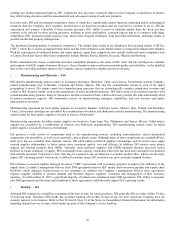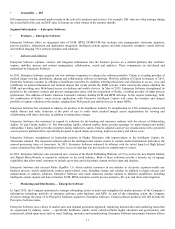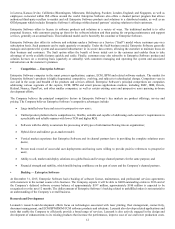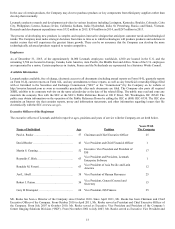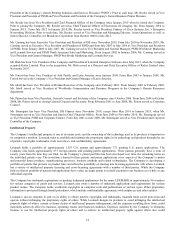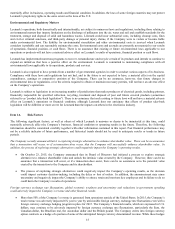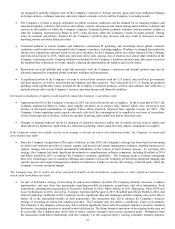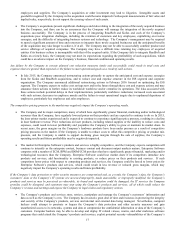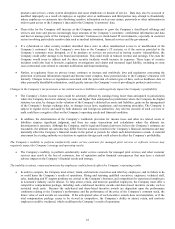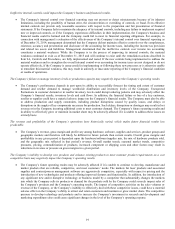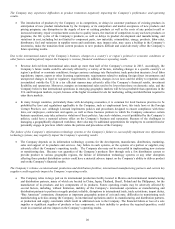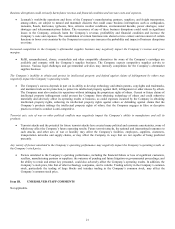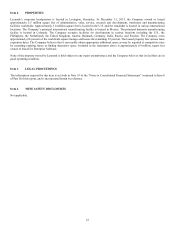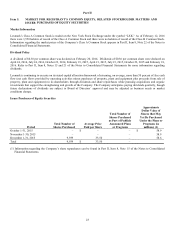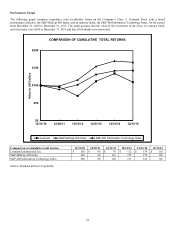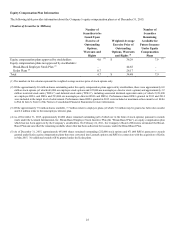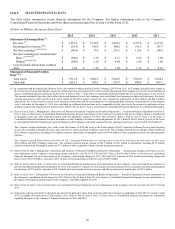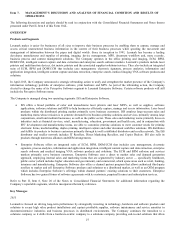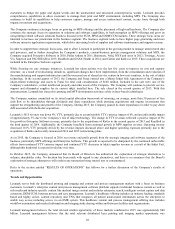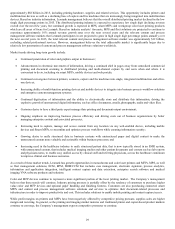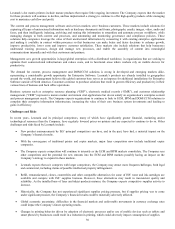Lexmark 2015 Annual Report Download - page 24
Download and view the complete annual report
Please find page 24 of the 2015 Lexmark annual report below. You can navigate through the pages in the report by either clicking on the pages listed below, or by using the keyword search tool below to find specific information within the annual report.20
The Company may experience difficulties in product transitions negatively impacting the Company’s performance and operating
results.
The introduction of products by the Company or its competitors, or delays in customer purchases of existing products in
anticipation of new product introductions by the Company or its competitors and market acceptance of new products and
pricing programs, any disruption in the supply of new or existing products as well as the costs of any product recall or
increased warranty, repair or replacement costs due to quality issues, the reaction of competitors to any such new products or
programs, the life cycles of the Company’s products, as well as delays in product development and manufacturing, and
variations in cost, including but not limited to component parts, raw materials, commodities, energy, products, labor rates,
distributors, fuel and variations in supplier terms and conditions, may impact sales, may cause a buildup in the Company’s
inventories, make the transition from current products to new products difficult and could adversely affect the Company’s
future operating results.
Due to the international nature of the Company’s business, changes in a country’s or region’s political or economic conditions or
other factors could negatively impact the Company’s revenue, financial condition or operating results.
Revenue derived from international sales made up more than half of the Company’s revenue in 2015. Accordingly, the
Company’s future results could be adversely affected by a variety of factors, including changes in a specific country’s or
region’s political or economic conditions; foreign currency exchange rate fluctuations; trade protection measures; local labor
regulations; import, export or other licensing requirements; requirements related to making foreign direct investments; and
unexpected changes in legal or regulatory requirements. In addition, changes in tax laws and the ability to repatriate cash
accumulated outside the U.S. in a tax efficient manner may adversely affect the Company’s financial results, investment
flexibility and operations. Moreover, margins on international sales tend to be lower than those on domestic sales, and the
Company believes that international operations in emerging geographic markets will be less profitable than operations in the
U.S. and European markets, in part, because of the higher investment levels for marketing, selling and distribution required to
enter these markets.
In many foreign countries, particularly those with developing economies, it is common for local business practices to be
prohibited by laws and regulations applicable to the Company, such as employment laws, fair trade laws or the Foreign
Corrupt Practices Act. Although Lexmark implements policies and procedures designed to ensure compliance with these
laws, our employees, contractors and agents, as well as those business partners to which the Company outsources certain
business operations, may take actions in violation of these policies. Any such violation, even if prohibited by the Company’s
policies, could have a material adverse effect on the Company’s business and reputation. Because of the challenges in
managing a geographically dispersed workforce, there also may be additional opportunities for employees to commit fraud or
personally engage in practices which violate the policies and procedures of the Company.
The failure of the Company’s information technology systems or the Company’s failure to successfully implement new information
technology systems, may negatively impact the Company’s operating results.
The Company depends on its information technology systems for the development, manufacture, distribution, marketing,
sales and support of its products and services. Any failure in such systems, or the systems of a partner or supplier, may
adversely affect the Company’s operating results. The Company also may not be successful in implementing new systems
or transitioning data. Because vast quantities of the Company’s products flow through only a few distribution centers to
provide product to various geographic regions, the failure of information technology systems or any other disruption
affecting those product distribution centers could have a material adverse impact on the Company’s ability to deliver product
and on the Company’s financial results.
The Company’s reliance on international production and distribution facilities, international manufacturing partners and certain key
suppliers could negatively impact the Company’s operating results.
The Company relies in large part on its international production facility located in Mexico and international manufacturing
and distribution partners, many of which are located in China, Japan, Thailand, Brazil, Poland and the Philippines, for the
manufacture of its products and key components of its products. Future operating results may be adversely affected by
several factors, including, without limitation, inability of the Company’s international operations or manufacturing and
distribution partners to perform or supply products reliably, disruptions in international trade, trade restrictions, import duties,
“Buy American” constraints, disruptions at important geographic points of exit and entry, difficulties in transitioning such
manufacturing activities among the Company, its international operations and/or its manufacturing and distribution partners,
or production and supply constraints which result in additional costs to the Company. The financial failure or loss of a sole
supplier or significant supplier of products or key components, or their inability to produce the required quantities, could
result in a material adverse impact on the Company’s operating results.


